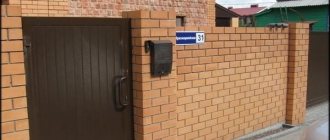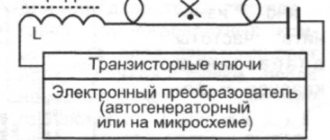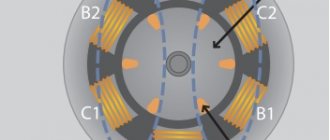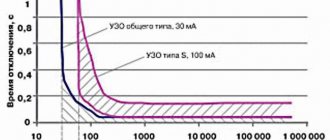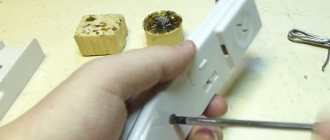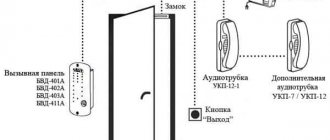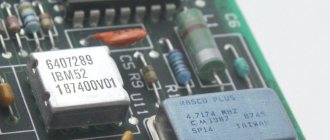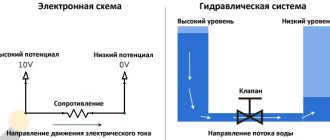In this material we will try to introduce the reader to the structure of intercoms, the principle of operation and the purpose of its main components.
Purpose of the intercom
As mentioned at the beginning of this material, intercoms are used to restrict access of unwanted persons to a certain area. In the case of multi-user systems, these are the entrances of multi-apartment residential buildings. Single-user (low-user) systems usually restrict access to private households.
In order to enter the territory “protected” by the intercom, a person must go through an identification procedure. Identification can be done using:
- voice recognition during negotiations over a voice communication device (in recent years, video intercom systems have made it possible to identify people visually);
- using an individual electronic key;
- by typing the secret code on the numeric keypad.
In the first case, the decision to grant access is made by the user of the intercom system. In other cases, the identification procedure is performed by a microprocessor device.
Additional functions and design elements
In principle, all other auxiliary components not mentioned earlier must expand the functionality of the system and increase its reliability, otherwise they simply do not make sense.
— a canopy covering the outdoor calling panel protects it from moisture in the event of snow or rain;
— an additional call button allows you to invite the concierge if you have lost your own key or, as a guest, have forgotten the specific address of the person you are visiting;
— illumination, which allows you to transmit to the cameras the highest quality image of the visitor at night or in adverse weather conditions.
In addition, video intercom control panels can have an interface for connecting additional cameras in order to organize video surveillance from several points, and also interact with a motion sensor that activates video recording when any monitoring events begin.
Read also: Heat treatment of 40x steel, hardening, tempering
In order not to waste money on advanced functionality that is unlikely to be useful to you in reality, before purchasing a specific video intercom system, clearly define the tasks that it must perform and take into account the existing operating conditions.
Main components of intercom systems
Multi-user intercom systems consist of several main units. A typical intercom circuit consists of:
- call block;
- power supply;
- electric lock;
- switching unit;
- subscriber voice handsets.
The figure shows a block diagram of an intercom of an apartment building with a coordinate switch.
Below we will take a detailed look at the structure of all elements of the intercom system.
Electric lock
In modern multi-user intercom systems, two types of electric locks are used:
- electromechanical;
- electromagnetic.
In electromechanical locks, the bolt (bolt) of the locking device is held in the “closed” state when power is applied to the coil of the built-in electromagnet. When the tension is removed, the bolt comes out of the locking plate under the action of the return spring.
Electromagnetic locks lock doors using a magnetic field.
A powerful electromagnet coil mounted on part of an open magnetic circuit is built into the door frame. The second part of the magnetic circuit is mounted on the door. At the moment when the door comes close to the door frame, the halves of the magnetic circuit are attracted to each other under the influence of a magnetic field. When the magnetic circuit “shorts”, the door is kept locked. To overcome the resistance of an electromagnet requires an effort that an ordinary person is unable to create without additional means.
From the above description of the locks of multi-user systems, it is clear that when the supply voltage disappears, they automatically open . This arrangement of locks makes intercom systems vulnerable, but it is dictated by fire safety requirements.
As for the locks of individual intercoms, they are opened using an electromagnet when the supply voltage is applied. The connection diagram for the electromechanical lock is shown in the figure.
In order for entrance doors with electric locks to be able to lock automatically, they are equipped with door closers.
power unit
Intercom power supplies produce power supply voltages for all elements of intercom systems. There are no special requirements for power supplies other than reliability. To increase the reliability of the operation of intercoms, power supplies can be supplemented with uninterruptible power supplies. The use of uninterruptible systems will allow the intercom to continue operating during power outages.
Call block
The call block is the “brain” of the intercom system. Typically a calling block consists of:
- numeric keypad;
- a display reflecting the numbers typed on the keyboard;
- elements of duplex public address system (speaker, microphone);
- electronic key code reader;
- buttons for opening the door from inside the room.
Depending on the type of intercom system and the algorithm of its operation, when typing a combination of numbers on the numeric keypad, you can enter an access code or call a subscriber of one of the apartments. If there is a display, it will display the entered digital sequence.
It should be noted that the use of a secret code in modern intercoms is practically not used.
The latest intercom systems are opened using individual electronic keys (chips). The key chips store a unique code that is read by a special reader. The read code is analyzed by the call block microcontroller. If the entered code matches the code “hardwired” into the call block, the microcontroller will issue a signal to open the door.
In addition to the identification function using a key, the call block performs the function of controlling the switching of voice communication devices. When dialing an apartment number, the speaker and microphone are turned on, and control signals are generated for the switching unit. The switching unit transmits the call signal to the subscriber handset. If the handset is picked up, the caller has the opportunity to conduct a conversation with people in the apartment. Intercoms provide duplex (two-way) voice communication between the calling device and the subscriber device.
If the “open” button is pressed on the subscriber side, the permission signal will be sent to the call block through the switch. The microprocessor system will turn off the power to the lock electromagnet and the front door will open. The door will also open when you press the open button from inside the room.
Switching block
Using the switching unit, a telephone connection is made between the call unit and the subscriber unit. Modern intercom systems mainly use coordinate-type switching units. The device operates according to the following algorithm. The switching unit receives from the conversation unit a sequence of control signals encoding the number of the apartment receiving device (handset).
Depending on the apartment number, two wires are selected that connect the subscriber device to the speaking part of the calling device. Without going into details, we can say that with the coordinate switching method, only 20 wires are required to connect 99 apartment tubes.
Apartment intercom device (handset)
An apartment intercom handset is not much different from the handsets of conventional telephones. With its help, you can carry on a conversation with the person who called the apartment and open the front door.
A microphone with a transistor amplifier is built into the handset body, a speaker which, depending on the position of the handset, serves as a telephone captcha or a call buzzer. An LED is installed on the device body to indicate the presence of a line.
Opening the door from the subscriber's apartment occurs as follows. When you press the “open” button on the housing of the apartment intercom, the resistance of the telephone line changes. A change in line resistance is perceived by the microprocessor device as an “open” signal.
Schematic diagram of the intercom handset
When connecting speaking handsets, polarity must be observed.
Device connection features
Before connecting and interconnecting individual components, you must study the instructions provided by the equipment manufacturer. When installing a video intercom calling panel and laying a communication line, it is necessary to provide protection from mechanical damage and exposure to precipitation.
To reduce the level of possible interference and improve the quality of the transmitted picture, connecting wires must be laid away from power lines.
Connection of individual devices is carried out only when the power supply is de-energized. If you forget this rule, then in case of accidental short circuits the equipment may fail.
DIY installation
If you have skills in arranging electrical networks, then you can install and connect the intercom yourself. The general scheme of work in this case is as follows:
- A monitor is mounted in the room and connected to the home electrical network. There are no particular difficulties at this stage.
- The calling panel is installed on the wall near the front door or gate. It is recommended to deepen it into the masonry, this will increase the protection of the device from moisture and mechanical damage. The installation height is from 1.4 to 1.6 m. This will allow you to focus the camera on the face of a person of average height.
- It is advisable to lay connecting wires underground. Significant depth is not required; 25–30 cm is sufficient. Plastic or steel pipes of the appropriate diameter are used for installation.
- In sets without key readers, all main devices are connected directly to the calling panel. And in video intercoms with such readers, the main controller is considered to be the control controller, to which other equipment is connected.
Strong recommendation: before connecting the video intercom, be sure to check compliance with the basic connection diagram.
Helpful installation tips
It is recommended to pay attention to the recommendations of specialists involved in the installation of video surveillance systems:
- The best picture is provided by cameras with a viewing angle of 30–60 degrees.
- Only a video intercom with IR illumination will provide a normal image in the dark.
- You should not install the calling panel on doors or entrance gates. When opened, the connecting wires quickly fail.
- The most useful are video intercoms with a vandal-proof calling panel.
If you do not have experience in installing and connecting devices of this class, then the configuration and installation should be entrusted to a qualified technician.
Types of intercom code keys and the principle of their operation
Intercom code keys can be divided into two types: contact and contactless. The first intercoms used simple analog keys with two contacts. A resistor of a certain value was soldered inside such a key. When such a key was applied to the reader, a fixed current was passed through it, and the microprocessor system measured the voltage drop across the resistor.
If the fall fell within the specified parameters, the door opened. Such a key could be made not only by an intercom service company, but also by any person with basic knowledge of electrical engineering. Therefore, analog keys were quickly replaced by chips that transmit serial binary code . For such keys, the number of possible combinations is determined by the number of transmitted binary digits.
Contact-type digital keys can be made based on chips from different companies. One of the most common are Dallas Touch Memory from the same manufacturer. Depending on the microchip model, the keys have different amounts of memory and allow you to obtain a different number of numerical combinations.
Recently, many intercoms have been equipped with contactless reading devices. In this case, the exchange between the access key and the intercom is carried out over a radio channel. The devices communicate with each other at frequencies of several tens or hundreds of kilohertz. The range of such “radio equipment” does not exceed several centimeters. Therefore, the possibility of intercepting radio traffic is unlikely.
Call panel connection diagram and tips for making the best choice
The installation of a video intercom system should be carried out in maximum accordance with the recommendations of its manufacturer. This list includes:
- — installation option (placement inside the door leaf, on the wall adjacent to the door, on the surface of the door, etc.);
- — diagram of interaction with other structural elements (lock control unit, door open button, other additional equipment);
- — method of power supply to system components (connection to a standard 220V power line, through its own voltage converter or through a control module for power distribution via internal cables).
In the technical documentation you can find out what types of cables the calling panel is connected to, what types of auxiliary devices it is compatible with, and what maximum operating loads it can withstand.
Connection diagram for a calling panel with a camera with an electromagnetic or electromechanical lock.
Most common models
In our country, equipment for intercom systems is supplied by several large companies. Among them we can highlight such manufacturers as Metakom LLC, the VIZIN group of companies (Visit). Both companies offer comprehensive solutions for organizing remote access control systems (ACS). Both companies present a wide range of intercom equipment.
Based on the proposed elements, you can create low-user and multi-user intercom systems of any configuration. The company's products are distinguished by a high level of quality and engineering. The equipment can operate in difficult weather conditions of our country. Anti-vandal design ensures high durability of products.
Installation of a video intercom calling panel
To connect we will need:
- multi-core cable for transmitting audio, video, power supply over a distance of up to 40 meters; — a pair of coaxial and two-core cables, allowing you to organize broadcasting over a line up to 500 meters long; - twisted pair cable, line range - up to 50 meters, this type of wire is not recommended for broadcasting color video signals; - a combined cable having a coaxial structure and several simple insulated conductors.
The best option is to choose an outdoor panel that is compatible with existing communication and power lines or has the same number of signal and power lines as the head unit. In addition, you need to consider the type of lock and purchase a call unit that is compatible with it.
Types of pipes
There are 2 main types of intercom handsets on the market:
- Analog.
- Digital.
Analog
To connect the equipment, you need a coordinate matrix switch that works like a telephone exchange. This device processes data from the outdoor unit and sends it directly to the handset installed inside the apartment after entering the number.
Installing an analog handset for an intercom is more difficult than the digital version, since the operating principle of the device requires additional cabling from the switch to subscribers.
Such tools create duplex communication, have control of the conversation volume and call signal, and can also remotely control the locking mechanism.

